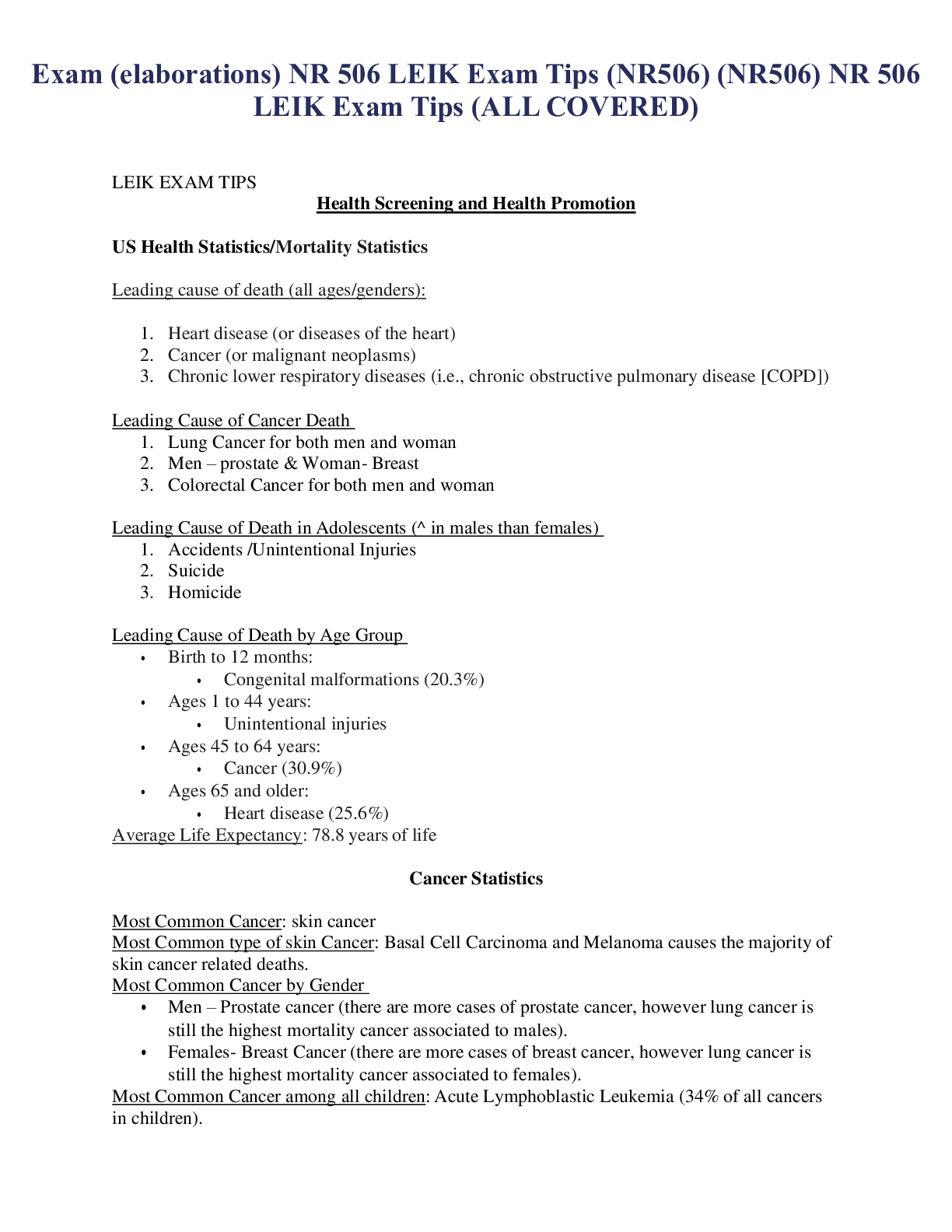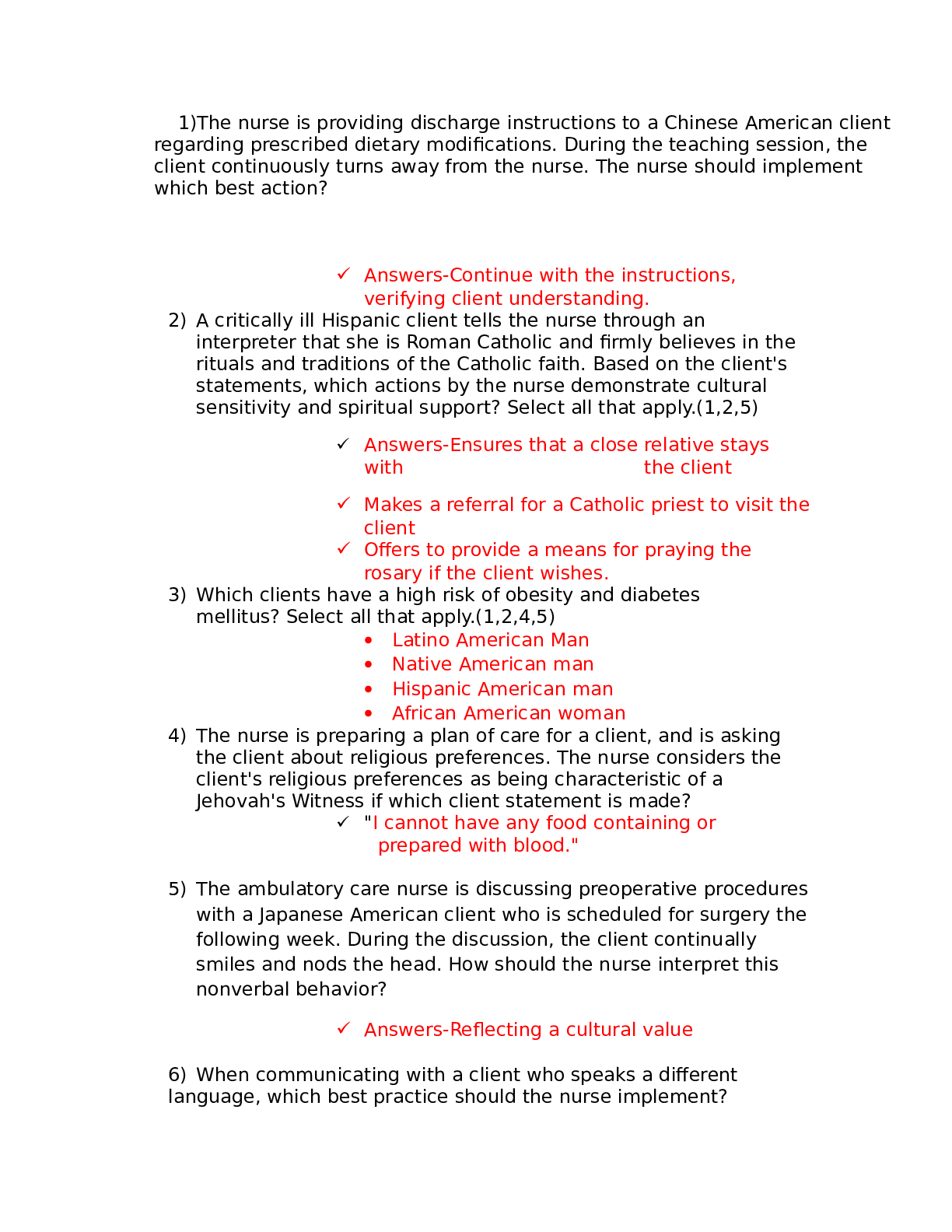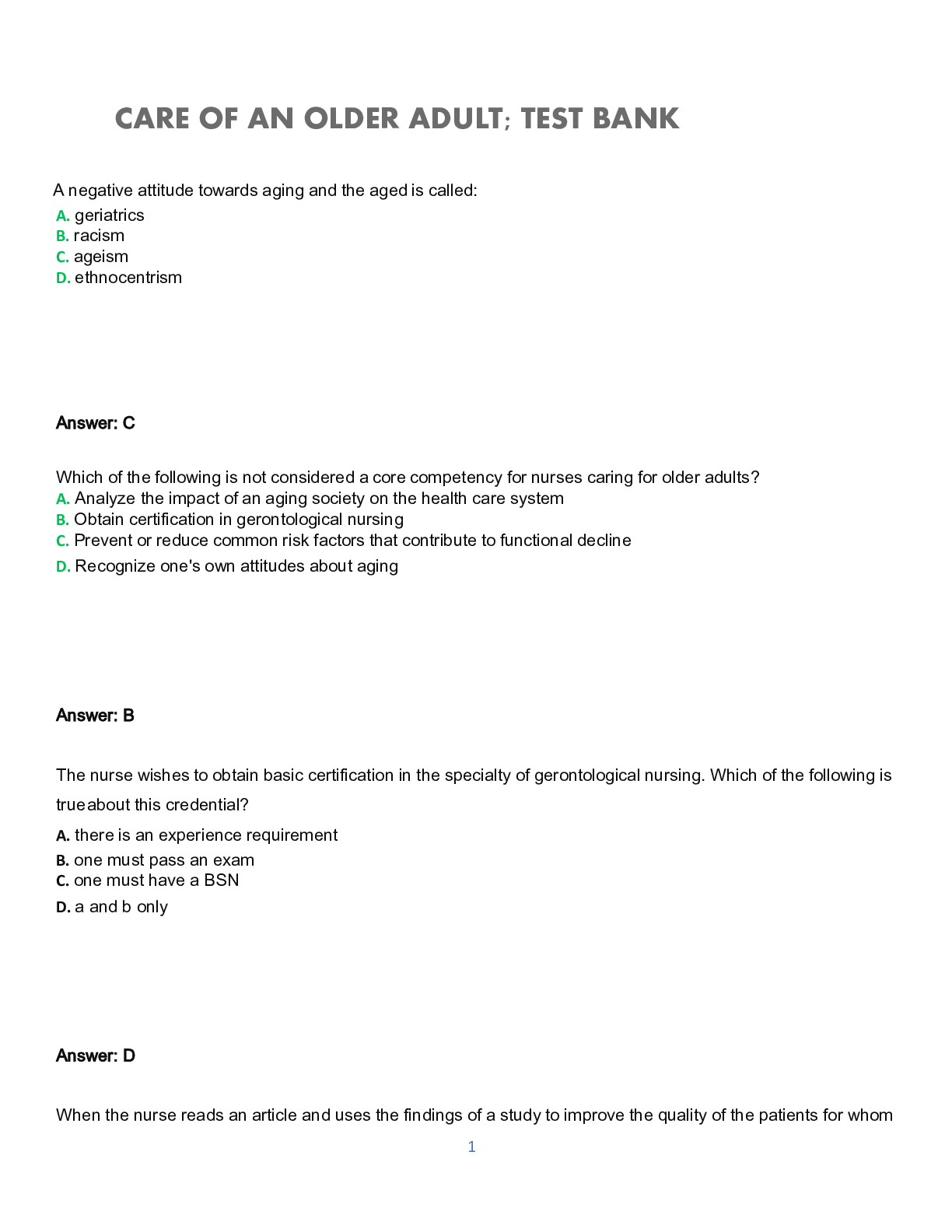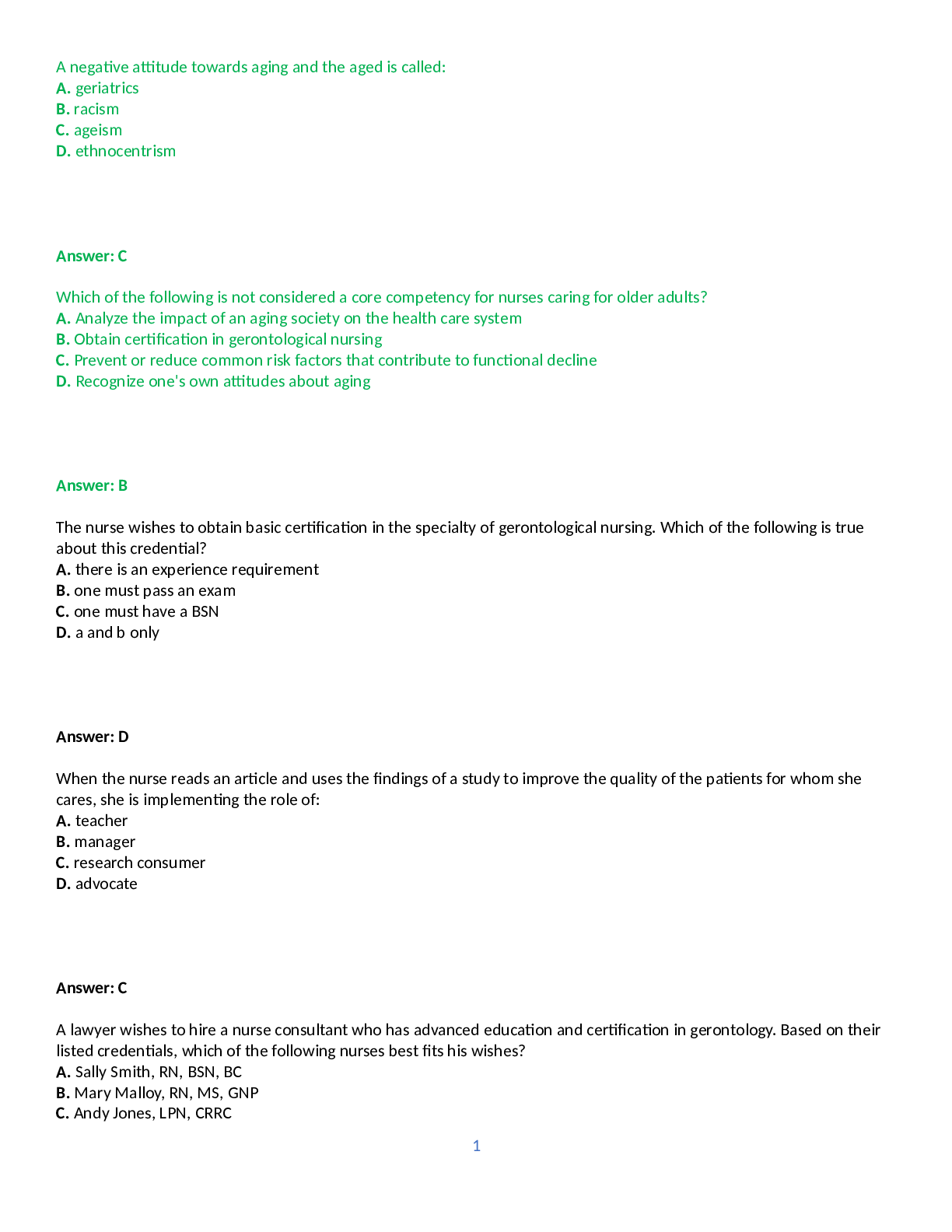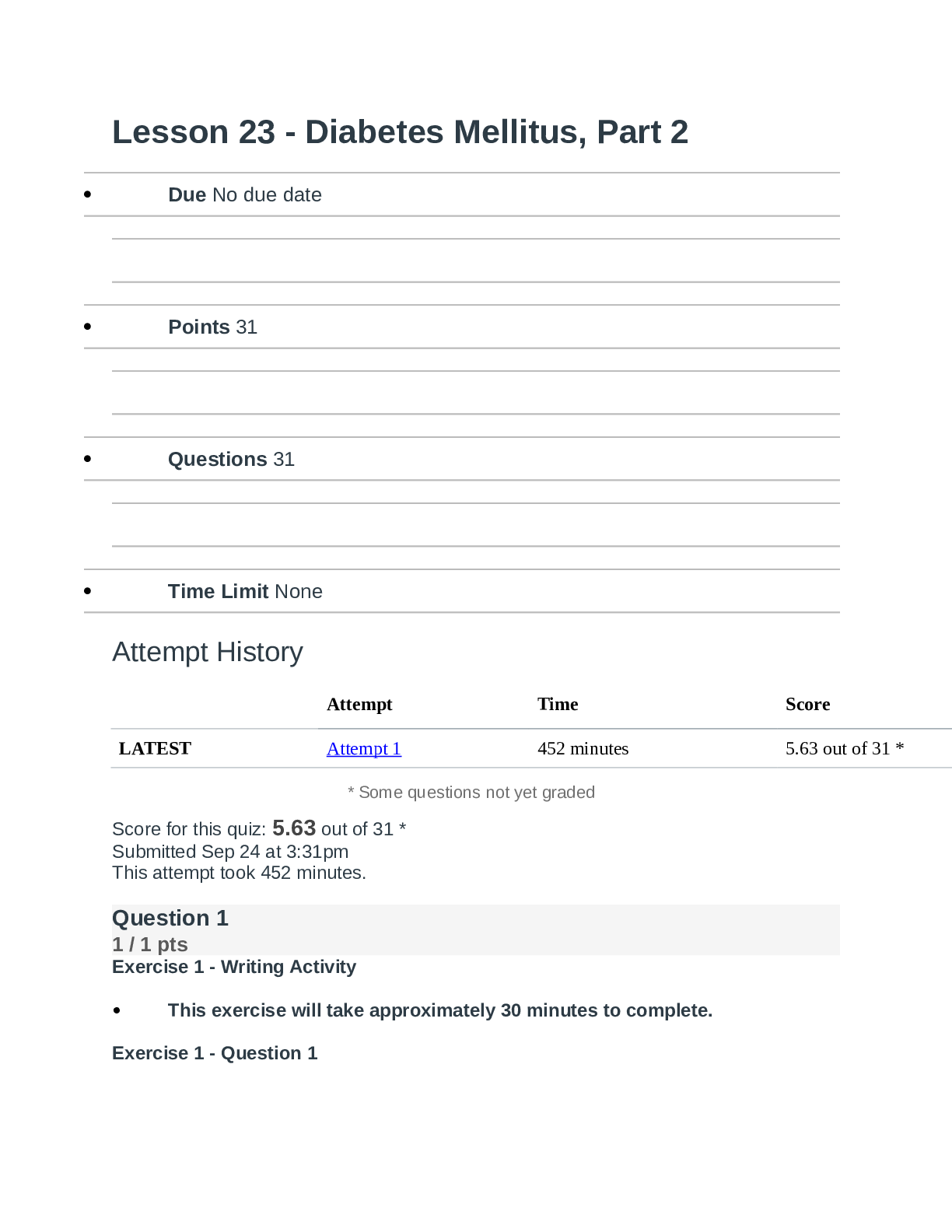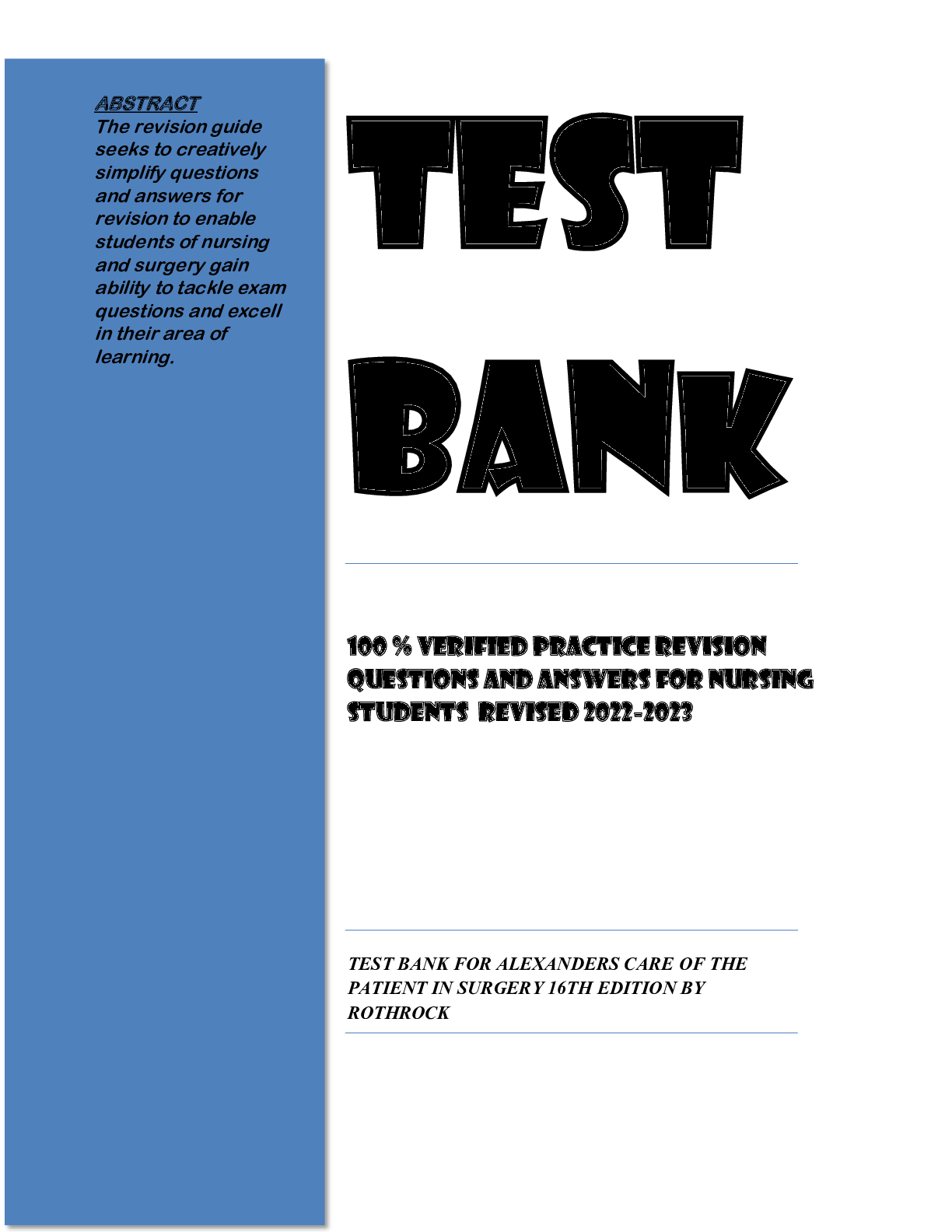*NURSING > QUESTIONS & ANSWERS > NURSING 01 (SOLVED MCQ) Family-Centered Care of the Child During Illness and Hospitalization (All)
NURSING 01 (SOLVED MCQ) Family-Centered Care of the Child During Illness and Hospitalization
Document Content and Description Below
Chapter 21: Family-Centered Care of the Child During Illness and Hospitalization MULTIPLE CHOICE 1. A nurse is caring for four patients; three are toddlers and one is a preschooler. Which represent... s the major stressor of hospitalization for these four patients? a. Separation anxiety b. Loss of control c. Fear of bodily injury d. Fear of pain ANS: A The major stressor for children from infancy through the preschool years is separation anxiety, also called anaclitic depression. This is a major stressor of hospitalization. Loss of control, fear of bodily injury, and fear of pain are all stressors associated with hospitalization. However, separation from family is a primary stressor in this age group. PTS: 1 DIF: Cognitive Level: Analyze TOP: Integrated Process: Nursing Process: Evaluation MSC: Area of Client Needs: Health Promotion and Maintenance 2. During the first 4 days of hospitalization, Eric, age 18 months, cried inconsolably when his parents left him, and he refused the staff’s attention. Now the nurse observes that Eric appears to be “settled in” and unconcerned about seeing his parents. The nurse should interpret this as which statement? a. He has successfully adjusted to the hospital environment. b. He has transferred his trust to the nursing staff. c. He may be experiencing detachment, which is the third stage of separation anxiety. d. Because he is “at home” in the hospital now, seeing his mother frequently will only start the cycle again. ANS: C Detachment is a behavior manifestation of separation anxiety. Superficially it appears that the child has adjusted to the loss. Detachment is a sign of resignation, not contentment. Parents should be encouraged to be with their child. If parents restrict visits, they may begin a pattern of misunderstanding the child’s cues and not meeting his needs. PTS: 1 DIF: Cognitive Level: Analyze TOP: Integrated Process: Nursing Process: Diagnosis MSC: Area of Client Needs: Health Promotion and Maintenance 3. When a preschool child is hospitalized without adequate preparation, the nurse should recognize that the child may likely see hospitalization as: a. punishment. b. threat to child’s self-image. c. an opportunity for regression. d. loss of companionship with friends. ANS: A REF: 613 REF: 613If a toddler is not prepared for hospitalization, a typical preschooler fantasy is to attribute the hospitalization to punishment for real or imagined misdeeds. Attributing the hospitalization to punishment for real or imagined misdeeds is a reaction typical of toddler and school-age children when threatened with loss of control. PTS: 1 DIF: Cognitive Level: Understand TOP: Integrated Process: Nursing Process: Diagnosis MSC: Area of Client Needs: Health Promotion and Maintenance 4. Which age group should the pediatric nurse recognize as being vulnerable to events that lessen their feeling of control and power? a. Infants b. Toddlers c. Preschoolers d. School-age children ANS: D When a child is hospitalized, the altered family role, physical disability, loss of peer acceptance, lack of productivity, and inability to cope with stress usurp individual power and identity. This is especially detrimental to school-age children, who are striving for independence and productivity and are now experiencing events that lessen their control and power. Infants, toddlers, and preschoolers, although affected to different extents by loss of power, are not as significantly affected as are school-age children. PTS: 1 DIF: Cognitive Level: Understand TOP: Integrated Process: Nursing Process: Diagnosis MSC: Area of Client Needs: Health Promotion and Maintenance 5. A 10-year-old girl needs to have another intravenous (IV) line started. She keeps telling the nurse, “Wait a minute” and “I’m not ready.” The nurse should recognize this as which description? a. This is normal behavior for a school-age child. b. The behavior is not seen past the preschool years. c. The child thinks the nurse is punishing her. d. The child has successfully manipulated the nurse in the past. ANS: A The 10-year-old girl is attempting to maintain control. The nurse should provide the girl with structured choices about when the IV will be inserted. Telling the nurse “Wait a minute” and “I’m not ready” can be characteristic behavior when an individual needs to maintain some control over a situation. PTS: 1 DIF: Cognitive Level: Analyze TOP: Integrated Process: Nursing Process: Implementation MSC: Area of Client Needs: Health Promotion and Maintenance 6. The most common initial reaction of parents to illness or injury and hospitalization in their child is: a. anger. b. fear. c. depression. REF: 616 REF: 615 REF: 615d. disbelief. ANS: D Disbelief is the most common initial response of parents. This is especially true if the illness is sudden and serious. Anger or guilt is usually the second reaction stage. Fear, anxiety, and frustrations also are common feelings. Parents may finally react with some form of depression related to the physical and emotional exhaustion associated with a hospitalized child. PTS: 1 DIF: Cognitive Level: Understand TOP: Integrated Process: Nursing Process: Assessment MSC: Area of Client Needs: Psychosocial Integrity 7. Amy, age 6 years, needs to be hospitalized again because of a chronic illness. The clinic nurse overhears her school-age siblings tell her, “We are sick of Mom always sitting with you in the hospital and playing with you. It isn’t fair that you get everything and we have to stay with the neighbors.” Which is the nurse’s best assessment of this situation? a. The siblings are immature and probably spoiled. b. c. Jealousy and resentment are common reactions to the illness or hospitalization of a sibling. Family has ineffective coping mechanisms to deal with chronic illness. d. The siblings need to better understand their sister’s illness and needs. ANS: B Siblings experience loneliness, fear, and worry, as well as anger, resentment, jealousy, and guilt. The siblings experience stress equal to that of the hospitalized child. There is no evidence that the family has maladaptive coping mechanisms. PTS: 1 DIF: Cognitive Level: Analyze TOP: Integrated Process: Nursing Process: Assessment MSC: Area of Client Needs: Psychosocial Integrity 8. An appropriate nursing intervention to minimize separation anxiety in a hospitalized toddler would be to: a. provide for privacy. b. encourage parents to room in. c. explain procedures and routines. d. encourage contact with children the same age. ANS: B A toddler experiences separation anxiety secondary to being separated from the parents. To avoid this, the parents should be encouraged to room in as much as possible. Maintaining routines and ensuring privacy are helpful interventions, but they would not substitute for the parents. Encouraging contact with children the same age would not substitute for having the parents present. PTS: 1 DIF: Cognitive Level: Apply TOP: Integrated Process: Nursing Process: Implementation MSC: Area of Client Needs: Health Promotion and Maintenance 9. Four-year-old Brian appears to be upset by hospitalization. Which is an appropriate intervention? a. Let him know it is all right to cry. REF: 628 REF: 617 REF: 617b. Give him time to gain control of himself. Show him how other children are cooperating. c. d. Tell him what a big boy he is to be so quiet. ANS: A Crying is an appropriate behavior for the upset preschooler. The nurse provides support through physical presence. Giving the child time to gain control is appropriate, but the child must know that crying is acceptable. The preschooler does not engage in competitive behaviors. PTS: 1 DIF: Cognitive Level: Apply TOP: Integrated Process: Nursing Process: Implementation MSC: Area of Client Needs: Health Promotion and Maintenance 10. Latasha, age 8 years, is being admitted to the hospital from the emergency department with an injury from falling off her bicycle. Which will help her most in her adjustment to the hospital? a. Explain hospital schedules to her, such as mealtimes. b. Use terms such as “honey” and “dear” to show a caring attitude. c. Explain when parents can visit and why siblings cannot come to see her. d. Orient her parents, because she is young, to her room and hospital facility. ANS: A School-age children need to have control of their environment. The nurse should offer explanations or prepare the child for those experiences that are unavailable. The nurse should refer to the child by the preferred name. Explaining when parents can visit and why siblings cannot come to see her is telling the child all of the limitations, not helping her adjust to the hospital. At the age of 8 years, the child should be oriented to the environment along with the parents. PTS: 1 DIF: Cognitive Level: Apply TOP: Integrated Process: Nursing Process: Implementation MSC: Area of Client Needs: Health Promotion and Maintenance 11. Samantha, age 5 years, tells the nurse that she “needs a Band-Aid” where she had an injection. Which is the best nursing action? a. Apply a Band-Aid. b. Ask her why she wants a Band-Aid. c. Explain why a Band-Aid is not needed. d. Show her that the bleeding has already stopped. ANS: A Children at this age group still fear that their insides may leak out at the injection site. Provide the Band-Aid. No explanation should be required. The nurse should be prepared to apply a small Band-Aid after the injection. PTS: 1 DIF: Cognitive Level: Apply REF: 623 TOP: Integrated Process: Nursing Process: Implementation MSC: Area of Client Needs: Health Promotion and Maintenance: Growth and Development REF: 614 REF: 62112. Kimberly, age 3 years, is being admitted for about 1 week of hospitalization. Her parents tell the nurse that they are going to buy her “a lot of new toys, because she will be in the hospital.” The nurse’s reply should be based on an understanding of which concept? a. New toys make hospitalization easier. b. New toys are usually better than older ones for children of this age. c. At this age, children often need the comfort and reassurance of familiar toys from home. d. Buying new toys for a hospitalized child is a maladaptive way to cope with parental guilt. ANS: C Parents should bring favorite items from home to be with the child. Young children associate inanimate objects with people who are significant in their lives. The favorite items will comfort and reassure the child. Because the parents left the objects, the preschooler knows the parents will return. New toys will not serve the purpose of familiar toys and objects from home. The parents may experience some guilt as a response to the hospitalization, but there is no evidence that it is maladaptive. PTS: 1 DIF: Cognitive Level: Apply TOP: Integrated Process: Nursing Process: Implementation MSC: Area of Client Needs: Health Promotion and Maintenance 13. Matthew, age 18 months, has just been admitted with croup. His parent is tearful and tells the nurse, “This is all my fault. I should have taken him to the doctor sooner so he wouldn’t have to be here.” Which is appropriate in the care plan for this parent who is experiencing guilt? a. Clarify misconception about the illness. b. Explain to parent that the illness is not serious. c. Encourage parent to maintain a sense of control. d. Assess further why parent has excessive guilt feelings. ANS: A Guilt is a common response of parents when a child is hospitalized. They may blame themselves for the child’s illness or for not recognizing it soon enough. The nurse should clarify the nature of the problem and reassure parents that the child is being cared for. Croup is a potentially serious illness. The nurse should not minimize the parent’s feelings. It would be difficult for the parent to maintain a sense of control while the child is seriously ill. No further assessment is indicated at this time; guilt is a common response for parents. PTS: 1 DIF: Cognitive Level: Analyze TOP: Integrated Process: Nursing Process: Planning MSC: Area of Client Needs: Psychosocial Integrity 14. A 14-year-old boy is being admitted to the hospital for an appendectomy. Which roommate should the nurse assign with this patient? a. A 4-year-old boy with first day post-appendectomy surgery b. A 6-year-old boy with pneumonia c. A 15-year-old boy admitted with a vasoocclusive sickle cell crisis d. A 12-year-old boy with cellulitis ANS: C REF: 627 REF: 621 [Show More]
Last updated: 1 year ago
Preview 1 out of 11 pages
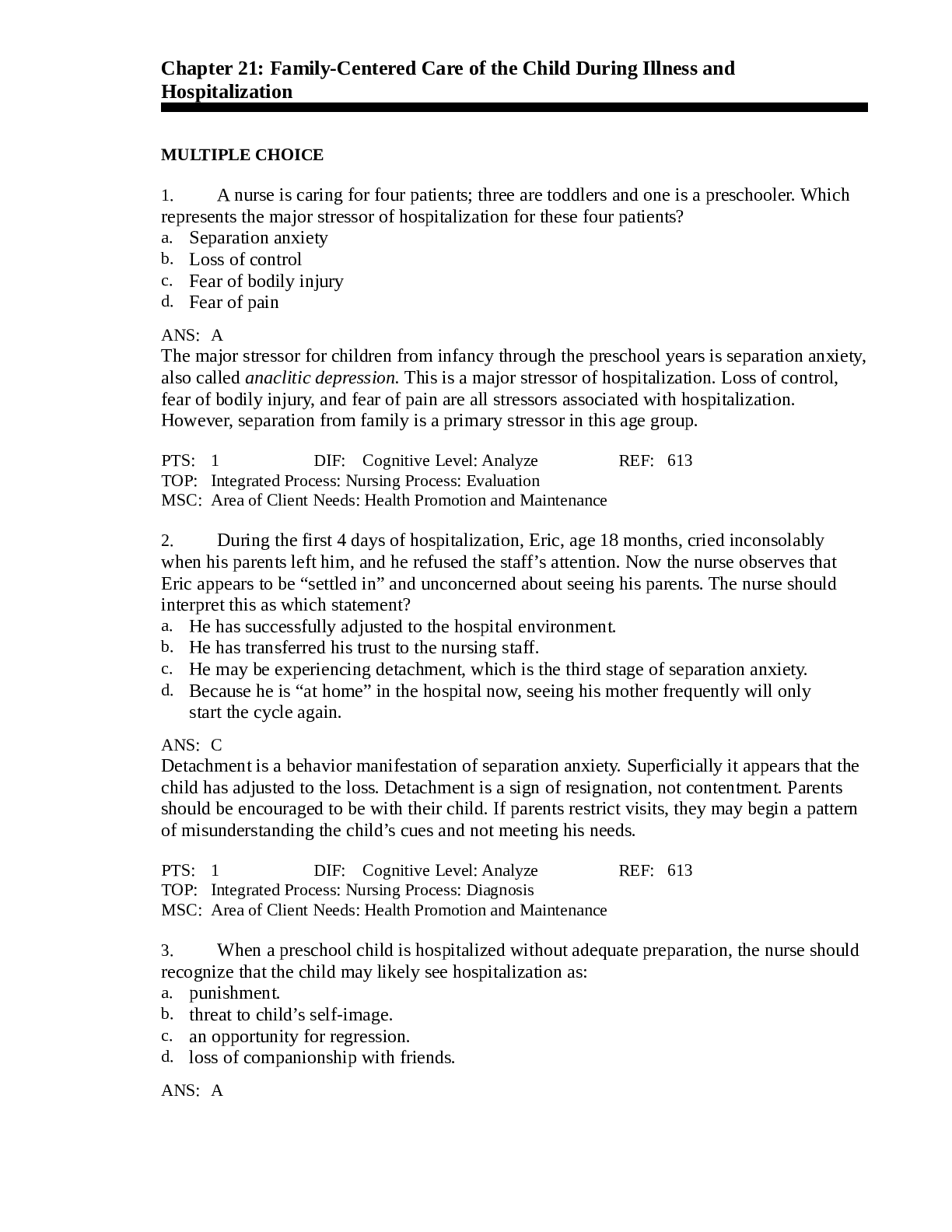
Reviews( 0 )
Document information
Connected school, study & course
About the document
Uploaded On
Sep 08, 2021
Number of pages
11
Written in
Additional information
This document has been written for:
Uploaded
Sep 08, 2021
Downloads
0
Views
71


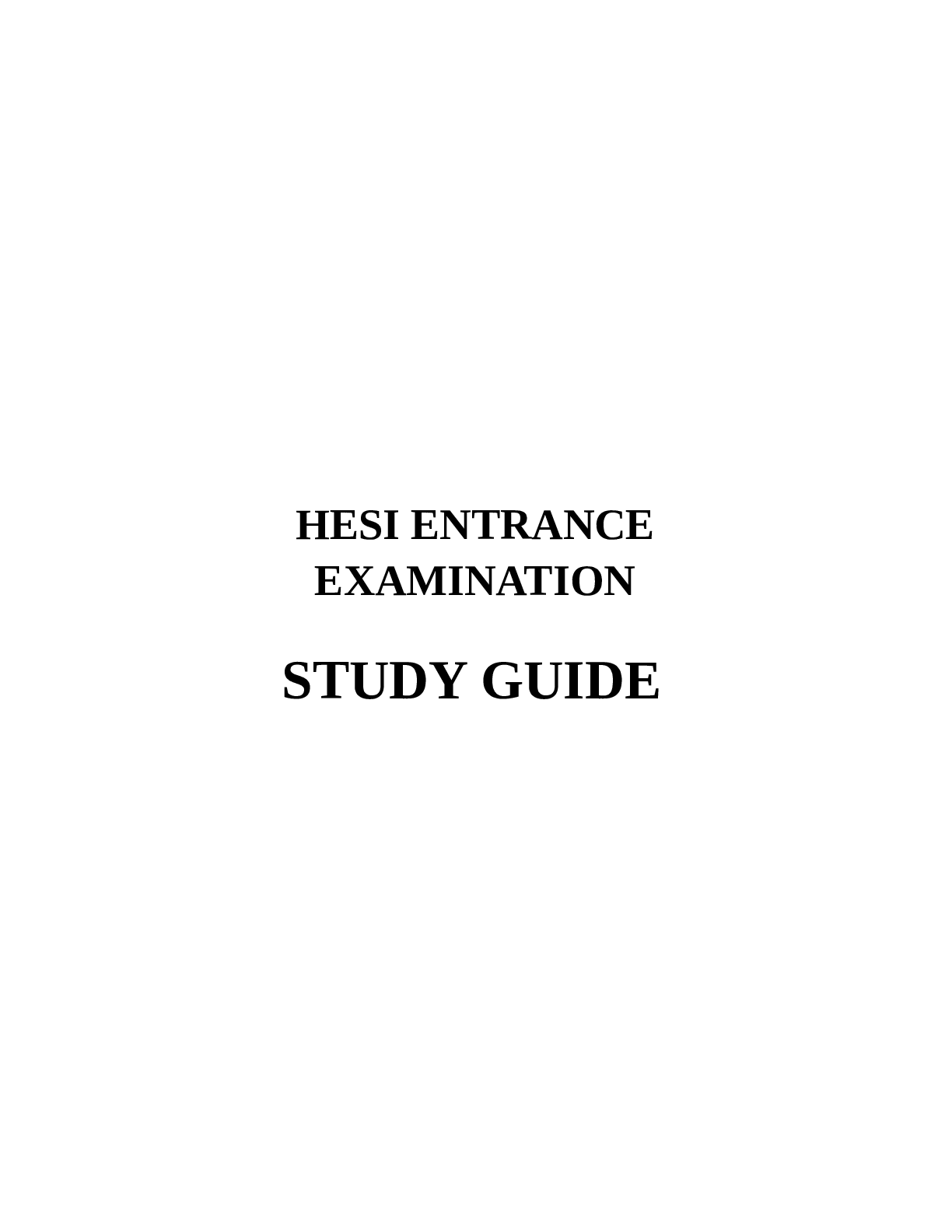
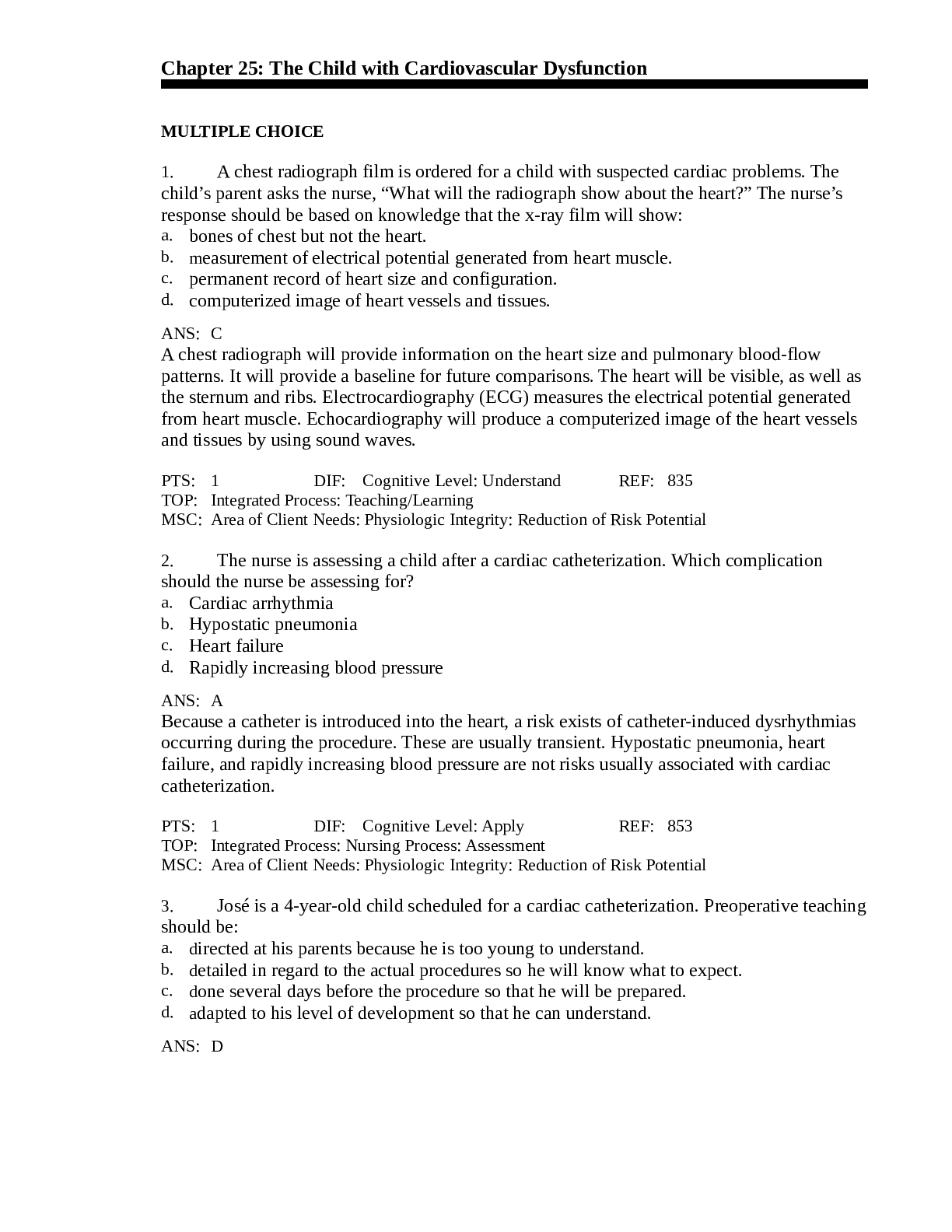
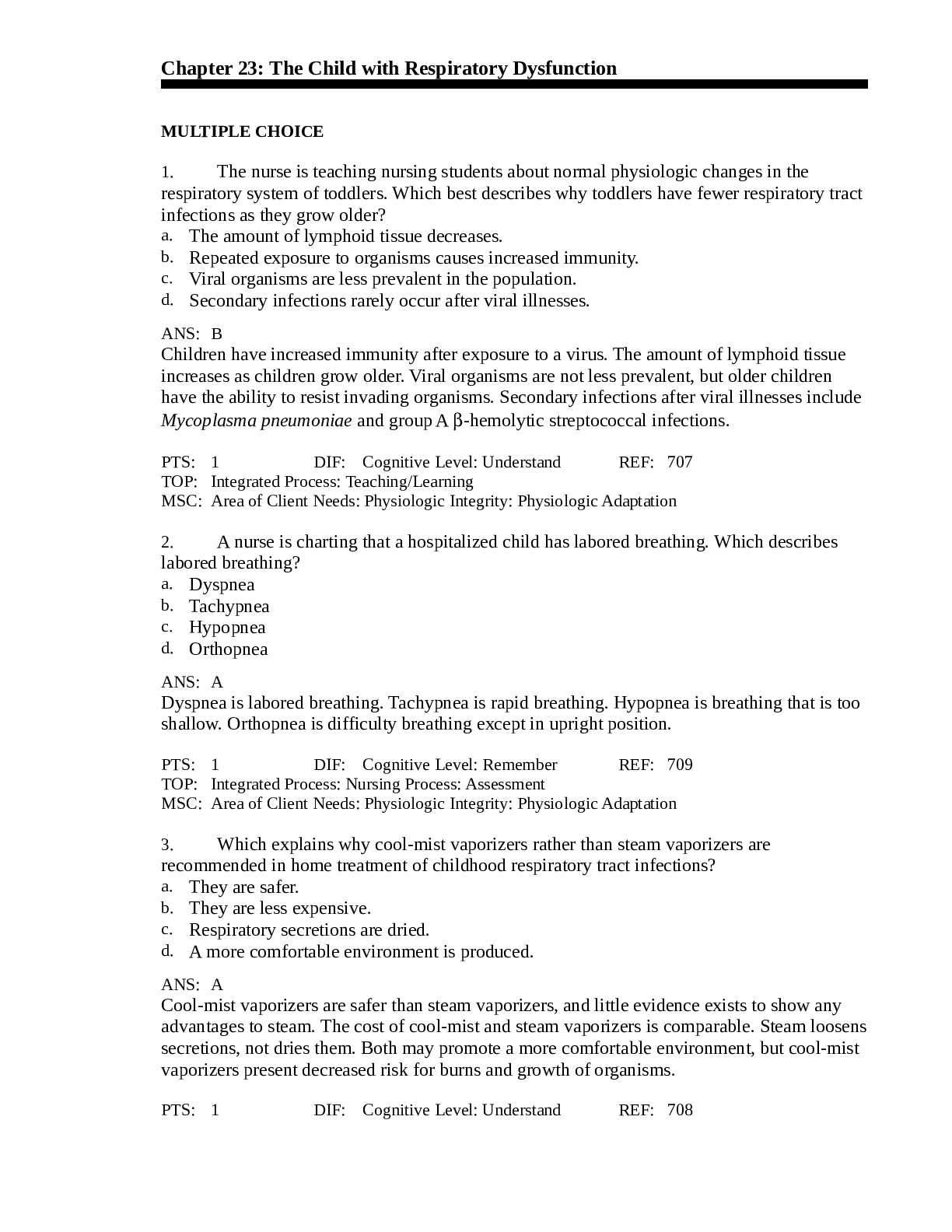
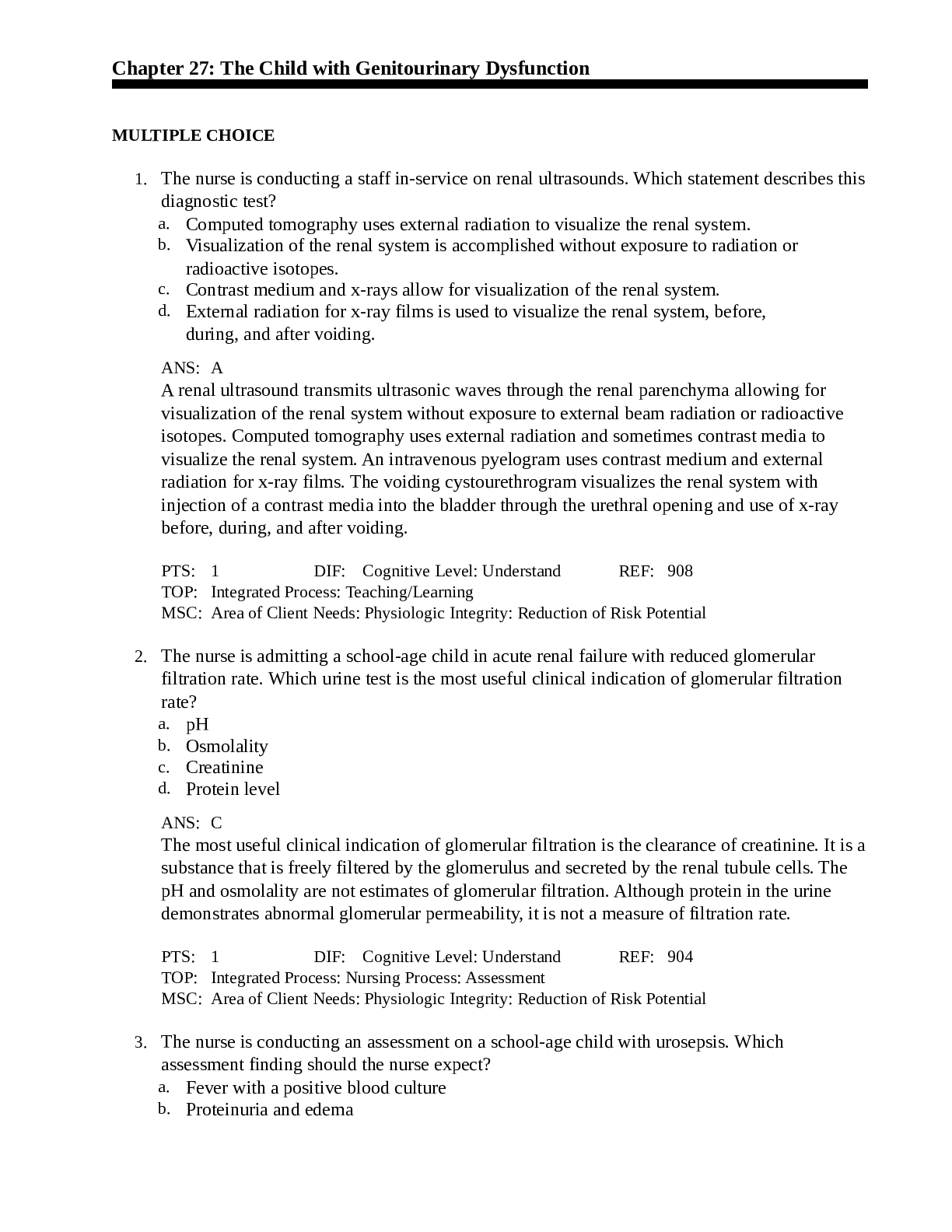
.png)



.png)

